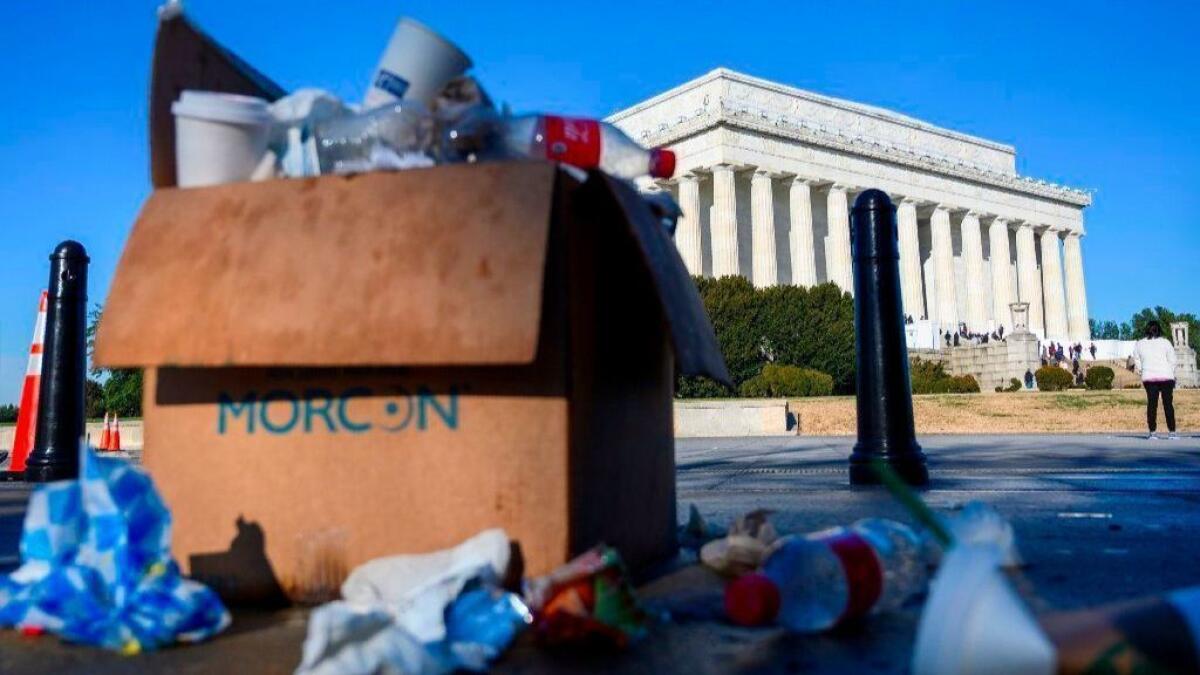Nearly one week in, here’s where things stand on the partial government shutdown

Reporting from Washington — About a quarter of the federal government has been shut down for six days as of late Thursday, and neither party in Congress nor President Trump seems to see much of a reason to compromise, yet.
Capitol Hill is a ghost town; for most of the day, newspapers stacked up outside the closed door to the suite belonging to Senate Majority Leader Mitch McConnell (R-Ky.). President Trump continued to fire off tweets signaling he was dug in on his demand for money to build a border wall. And Democrats tried a third time to get the House to approve a measure that the Senate approved unanimously last week, but which Trump rejected — because it lacked wall money.
There’s been no evident movement in Washington this week. Wondering how this standoff might end? Let’s jump right in.
How long is this going to last?
Into 2019, it’s all but certain. The House and Senate both confirmed on Thursday that they will have no votes this week. They’ve promised 24 hours’ notice to lawmakers dispersed for the holidays.
Even if members of Congress were summoned before New Year’s Day, it’s unclear how many would show up. (Remember, Democrats won a net gain of 40 House seats in November to take the majority; some Republicans who lost or are retiring haven’t had good attendance records in the weeks since.)
The new Congress will be sworn in on Jan. 3. Pomp and circumstance will take much of the day and then negotiations could begin. Because it takes a few days to get bills through both the House and Senate, reopening the shuttered government agencies in mid- to late January is possible. First, Congress has to have something both chambers can pass, and that Trump will sign.
Marc Short, Trump’s former legislative affairs director, told CNN on Thursday that it could be a few weeks before a compromise is reached.
Aren’t they already negotiating in some smoke-filled room?
Leaving aside that smoking has long been banned in most of the Capitol, all signs point to no negotiations — only dueling news releases blaming the other party.
Really?
Really. Let me explain why.
Democrats have little incentive to compromise before they take control of the House next week — and gain a lot of leverage. Although Republicans will hold two more Senate seats than they’ve had, their still-narrow majority means they will still need some Democrats’ votes to pass legislation.
Yet Trump and his hard-line allies among House Republicans have their own reason to stand their ground for now: These last days of Republican control of all three legislative levers — the White House, House and Senate — are likely the president’s last chance to get the funding he wants for his border wall.
He does not want to look like he is backing down from his campaign promise now. That’s just the argument that his allies in the conservative House Freedom Caucus successfully used to coax Trump into holding firm to his demand for $5 billion for the wall, and forcing the shutdown.
Remind us, how did we get here?
Congress passed the annual appropriations bills to fund about 75% of the government before the current fiscal year began Oct. 1. (Something it has rarely done in recent years.) Members gave themselves an extension into December to fund the rest, covering a number of federal departments and a handful of ancillary independent agencies that include NASA.
By December all sides had agreed on funding levels for those agencies, including $1.6 billion for border security, some of which would go toward wall construction.
With indications from the White House that Trump approved, the Senate unanimously passed that package and went home. It assumed the House would follow suit and the president would sign the legislation in time to avoid shutting down the government before Christmas.
But Trump, egged on by the conservative House Freedom Caucus and talk radio celebrities who said his legacy was at stake, reversed course. He announced he wouldn’t accept less than $5 billion for the wall and would be “proud” to shut down the government if he didn’t get it.
The hardliners had reminded Trump that he had already grudgingly signed a spending package in March with little of the full $25 billion he wanted for a wall, on assurance from Republican leaders that they would fight for more money in the next round of appropriations bills.
The House, rejecting the Senate-passed bill, narrowly passed a version that included more than $5 billion. The Senate, predictably, couldn’t follow suit before the deadline at midnight last Friday.
What’s actually closed, and why should I care?
The departments or agencies that have closed include the departments of Homeland Security, State, Agriculture, Commerce, Housing and Urban Development, Interior, Justice and Transportation, as well as independent agencies including NASA, the Food and Drug Administration and the Environmental Protection Agency.
None of the roughly 800,000 affected employees will receive a paycheck while the government is closed, though about 420,000 are considered essential and must report to work, including air traffic controllers and Border Patrol agents. (In the past, Congress has approved back pay, but that doesn’t cover any late fees, interest or other costs people incur for missed or late bill payments.)
About 44,000 active-duty members of the Coast Guard are working without pay because they are the only branch of the military funded under the Homeland Security Department’s budget rather than the Pentagon’s.
The Smithsonian Institution has announced that all museums and galleries will close Jan. 2, disappointing tourists from all over. National parks are closed, though some states are maintaining operations at the most popular parks. Trying to buy a home? The Federal Housing Administration and the IRS are less responsive because they don’t have the staff needed to process and approve loans or provide needed tax information.
The Federal Emergency Management Agency announced Wednesday that the National Flood Insurance Program cannot issue new policies, even though Congress passed legislation last week authorizing the program to operate through May. Proof of such policies is required to get some mortgages; the National Assn. of Realtors estimates that 40,000 home closings are delayed each month the agency can’t issue flood insurance policies. FEMA will continue processing flood damage claims.
Want to start a business in the new year? The Small Business Administration cannot process new business loan applications. Need help financing crops this spring? The Agriculture Department has said it can’t provide farm loans if the shutdown continues for longer than a week.
The State Department, however, will continue processing passport and visa applications as long as it has money to do so.
Most Americans have been distracted by the holidays. But as the shutdown drags on, more people will feel the effects as they require services or otherwise have to interact with the closed agencies.
That’s important. In past shutdowns, public sentiment — anger and disgust — has played a big role in pushing the parties to compromise.
More stories from Sarah D. Wire »
Follow @sarahdwire on Twitter
More to Read
Get the L.A. Times Politics newsletter
Deeply reported insights into legislation, politics and policy from Sacramento, Washington and beyond. In your inbox three times per week.
You may occasionally receive promotional content from the Los Angeles Times.











